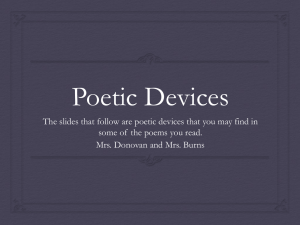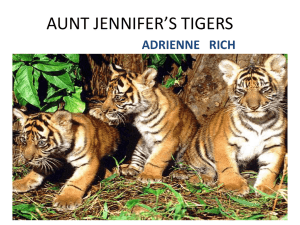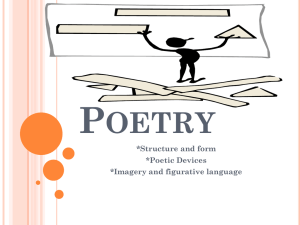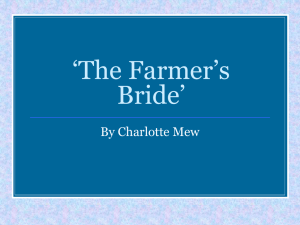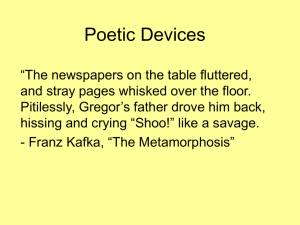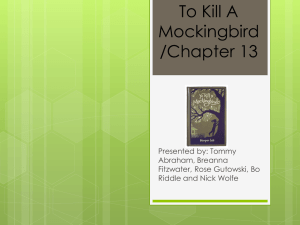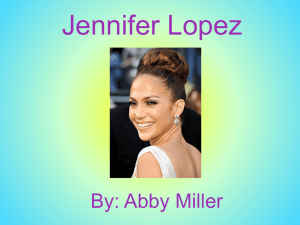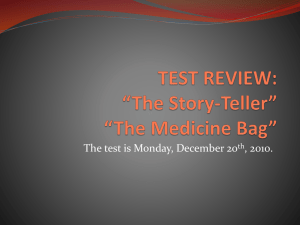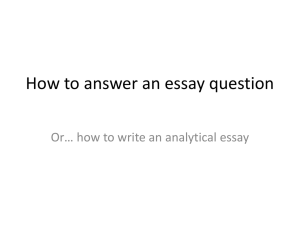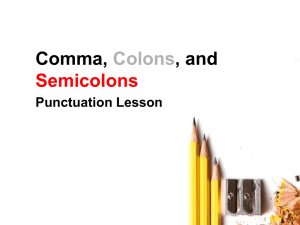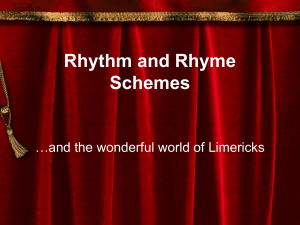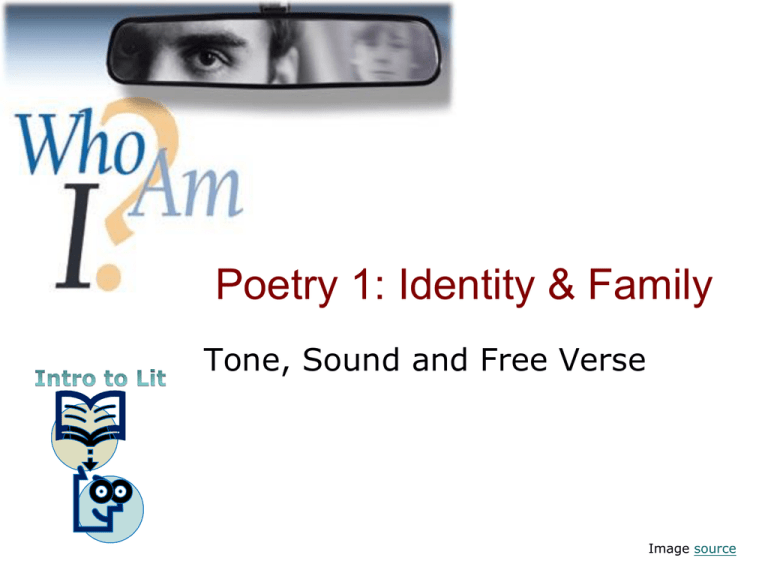
Poetry 1: Identity & Family
Tone, Sound and Free Verse
Image source
Outline
General Questions
Understanding the Poems’ Poetic Language
3 Gwendolyn Brooks "We Real Cool" (1960 p.
534)
6 Emily Dickinson "I'm Nobody! Who are you?" (1861
p. 683)
4 Walt Whitman “A Noiseless Patient Spider” (1891
p. 659)
5/2 Adrienne Rich “Aunt Jennifer’s Tiger”
1 Robert Hayden “Those Winter Sundays”
Lynn Lifshin “My Mother and the Bed”
Quiz 1 – Tone, Sound, Free Verse and
Lyric
Essay Questions and Review
General Questions
What is ‘identity’?
What determines our identities?
Text
Identity
Factors
“Story of an
Hour”
Gender
Creole society in New Orleans
+ marriage
“Rose for Emily”
Gender
The American South +
industrialism
“Alien”/Age
“Old Man with
Enormous Wings”
Religion + seaside village
“Araby”
Age/Gender
Religion vs. Commercialism +
Dublin’s social problem
“A & P”
Class/Gender
Small town America +
commercial society
Pygmalion
Class/Gender
Late Victorian society +
English
General Questions
What is ‘identity’?
What determines our identities?
Self
Black
Text
Identity
Factors
“We Real Cool”
Collective
“Cool” Actions
Black
“I’m Nobody.
Who Are you?”
Private and
Associative
Social visibility
“A Noiseless
Patient Spider”
Soul -Associative
Vast surrounding
“Aunt Jennifer’s
Tigers”
Gender
Family labor and death
“Those Winter
Sundays”
Familial
Family poverty and paternal
care; Black
“My Mother and
the Bed”
Familial
Daily order and maternal care
General Questions
Are parents always loving? What
makes their love difficult to
express, or 'difficult' for their
children to understand?
Understanding
Poetry
From Paraphrasing, Analysis to
Application
"We Real Cool" (1960 p. 685)
The Pool Players.
Seven at the Golden Shovel.
Lurk late. We
Strike straight. We
Sing sin. We
Thin gin. We
Jazz June. We
Die soon.
alliteration
internal rhymes
Strike straight:
1) attacking others;
2) play billiard balls
Jazz:
1) empty talk to or sex with
a woman named June;
2) going here and there in
June
.
repetitions
We real cool. We
Left school. We
"We Real Cool"
1.
2.
3.
4.
Paraphrasing
Analysis (1) Connotation: Speakers’
identity? Why “cool”?
Analysis (2) Poetic Language: Their tone?
How do the stress and sound Pattern
help convey the meaning? Symbol-Golden Shovel?
Analysis (3) What is “cool” for you?
Does developing a group identity matter
for you?
I'm Nobody! Who are you?
I'm Nobody! Who are you?
Are you--Nobody--too?
Then there's a pair of us!
Don't tell! they'd banish us—you know!
repetitions
How dreary--to be--Somebody!
How public--like a Frog-To tell your name--the livelong June-To an admiring Bog!
alliteration
Iambic meter
I'm Nobody! Who are you?
1.
2.
3.
4.
Paraphrasing
Analysis (1) Connotation: Speakers’
identity? That of “you”? The
differences between nobody and
somebody?
Analysis (2) Poetic Language: The
speaker’s tone in the 1st and 2nd stanzas?
The use of dashes? The metaphor of
bog and frog.
Analysis (3) Do you like to be a
somebody, or nobody? Or neither?
What do you feel about the speaker’s
criticism of “somebody” like a frog?
Emily Dickinson
(1830-1886)
A reclusive poet with mental
energies.
produced 1,775 known
poems as well as the
hundreds of letters. Only 7
(or 11) of the poems were
published anonymously in
her lifetime.
a traumatic experience
(between 1858 and 1862)
Stayed in her own house for
the last seventeen years of
her life.
Film: Emily Dickinson: The Poet
In Her Bedroom
http://www.youtube.com/watch
?v=PU8XijqmnT0
Walt Whitman "A Noiseless Patient Spider “
1.
Poem animation http://www.youtube.com/watch?v=0MLYFC1nBWU
2. http://www.youtube.com/watch?v=B7ui3PDC5to&feature=related
A noiseless patient spider
A noiseless patient spider,
I mark'd where on a little promontory (隆突) it stood
isolated,
repetitions
Mark'd how to explore the vacant vast(1) surrounding,
It launch'd forth filament, filament, filament, out of it self,
Ever unreeling them, ever tirelessly speeding them. (2)
Feminine
rhyme
Sounds:
“l,” “s,”
open
vowels e.g.
“o”
And you O my soul where you stand,
Surrounded, detached, in measureless oceans of space,
Ceaselessly musing, venturing, throwing, seeking (3) the
spheres to connect them,
Till the bridge you will need be form'd, till the ductile (柔軟
的) anchor hold,
Till the gossamer thread you fling catch somewhere, O
my soul. (4)
(1. consonance, 2, assonance, 3. internal rhyme, 4. alteration
between troche and dactyl. reference)
A Noiseless Patient Spider
1.
2.
3.
4.
Paraphrasing
Analysis (1) Connotation: What are the
implications in comparing the soul to a
spider? How are the activities of the spider
similar to and different from those of the
soul? The effects of the speaker’s
apostrophizing (頓呼) the soul ("O my
soul")?
Analysis (2) Poetic Language: The sound
and line patterns? The form of free verse.
Analysis (3) If you want to compare
yourself, or your mind, to an animal, which
would you choose and why?
Walt Whitman
A printer, teacher, journalist poet
hospital worker, government clerk,
later fired because of his poetry.
Publishes Leaves of Grass in 1855,
later revised 8 times.
A free thinker, sometimes without
regular jobs. (source)
portrait: from an 1854 engraving by Samuel Hollyer
Aunt Jennifer's Tigers
rhymes
Aunt Jennifer‘s tigers prance across a screen,
Bright topaz (黃水晶) denizens of a world of green.
They do not fear the men beneath the tree;
They pace in sleek chivalric certainty.
Aunt Jennifer's finger fluttering through her wool
Find even the ivory needle hard to pull.
The massive weight of Uncle's wedding band
Sits heavily upon Aunt Jennifer's hand.
Alliteratio
n, ‘p’
sound
When Aunt is dead, her terrified hands will lie
Still ringed with ordeals she was mastered by.
The tigers in the panel that she made
Will go on prancing, proud and unafraid.
Aunt Jennifer's Tigers
1.
2.
3.
4.
Paraphrasing
Analysis (1) Connotation: The relations
between Aunt Jennifer, her fingers,
wedding ring and her tigers– with pace
"in sleek chivalric certainty.“
Analysis (2) Poetic Language: the use of
tiger and wedding ring as symbols.
Analysis (3) How much can the
embroidered tigers represent aunt
Jennifer? Do you have relatives like her?
"Those Winter Sundays" (1962)
alliteration,
explosive sounds
Sundays too my father got up early
and put his clothes on in the blueblack cold,
then with cracked hands that ached
from labor in the weekday weather
made banked fires blaze. No one ever thanked him.
I'd wake and hear the cold splintering, breaking.
When the rooms were warm, he'd call,
and slowly I would rise and dress,
fearing the chronic angers of that house.
Open
vowels;
Long and
short lines
Speaking indifferently to him,
who had driven out the cold
and polished my good shoes as well,
What did I know, what did I know
of love's austere and lonely offices? [rituals, ceremonious]
"Those Winter Sundays" -1.
2.
3.
4.
Paraphrasing
Analysis (1) Connotation: the
contrast between the past view and
the present one about the
speaker’s father and his work.
Analysis (2) Poetic Language:
descriptions of the cold and the
house. Sound pattern.
Analysis (3) Does it matter to you
whether you know of the poet’s
background? Is the poem relevant
to you?
“My Mother and the Bed”
http://www.lynlifshin.com/bil-mompoems.htm
No, not that way she'd
say when I was 7, pulling
the bottom sheet smooth.
You've got to, saying
hospital corners
I wet the bed much later
than I should, until
just writing this I
hadn't thought of
the connection
“My Mother and Smelled
the Bed”
(2)
of smoke but
My mother would never
sleep on sheets someone
else had. I never
saw any stains on hers
tho her bedroom was
a maze of powder, hair
Pins, black dresses
She used to bring her
own sheets to my house,
carried toilet seat covers.
Lyn, did anybody sleep
in my, she always asked
Her sheets, her hair
she says the rooms here
smell funny
We drove at 3 am
slowly into Boston and
strip what looked like
two clean beds as the
sky got light. I
Smoothed on the form
fitted flower bottom,
she redid it.
She thinks of my life
as a bed only she
can make right
“My Mother and the Bed”
1.
2.
3.
4.
Paraphrasing
Analysis (1) Connotation: What’s
the mother’s long-term influence on
the daughter and her responses to it?
Analysis (2) Poetic Language: How
do the poetic form and the images
convey the meanings?
Analysis (3) How do you feel about
your parents’ ways of disciplining or
educating you?
Understanding
Poetic Language
Quiz 1: Sound and Sense
1. Which of the following is NOT a
free verse?
1. Aunt Jennifer's finger fluttering through her wool
Find even the ivory needle hard to pull.
2. It launch'd forth filament, filament, filament, out of
it self,
Ever unreeling them, ever tirelessly speeding them
3. No, not that way she'd
say when I was 7, pulling
the bottom sheet smooth.
You've got to, saying
hospital corners
4. I'm Nobody! Who are you?
Are you--Nobody--too?
Then there's a pair of us!
Don't tell! they'd banish us—you know!
Free Verse
A poetic form that does not rhyme, nor
use the metrical patterns of traditional
poetry. Rather, it establishes its own
patterns.
It is unrhymed, with no regular line length.
It has rhythmical lines varying in length.
Its patterns produced through repetition of
words, sounds and/or parallel grammatical
structure.
2. Which of the following is an
adequate description of the poem’s
sound effects?
1.
2.
3.
The explosive sounds in “Aunt Jennifer’s Tigers”
create a sense of hardship. (“Aunt Jennifer's
tigers prance across a screen, Aunt Jennifer's
tigers prance across a screen”)
The long and open vowels in “A Noiseless Patient
Spider” (“Till the bridge you will need be formed,
till the ductile anchor hold,/Till the gossamer
thread you fling catch somewhere ”) produces a
sense of continuity.
The dashes in “I’m Nobody. Who are you?” (e.g.
“Are you – Nobody – too? ”) create a sense of
continuity and calmness.
Sound & Sense
Different sounds create different
effects in different contexts. In
general
easily pronounced consonants (e.g. [l],
[r], [m], [n]) and open and long vowels
can be create a sense of ease or fluidity
Explosive sounds ([t], [d], [g], [k],[p]
[b]), sometimes combined with short
vowels, can create a sense of vitality or
difficulty.
nasal sounds ([m] & [n]) can create a
sense of melancholy
3. Which of the following is NOT part
of the functions of an apostrophe (頓
呼; “O my soul”)?
1.
2.
3.
4.
To compare the object to another
object
To personify the object addressed
To bring it (the absent object) to
presence
To show respect to the object.
Apostrophe
-- figure of speech in which an absent
person, a personified inanimate being,
or an abstraction is addressed as
though present;
-- the poet talks to (and personifies) the
one addressed.
4. Which of the following is not part of
the poetic sound pattern to consider?
1.
2.
3.
4.
5.
Repetition of consonants
(consonance) or assonants
(assonants)
Rhyme: alliteration, end rhyme
and internal rhyme
Stresses put on different syllables
(e.g. iambic)
The pauses in the poetic lines.
All of the above.
Rhyme & Rhythm
Rhyme is a sound device that usually entails
the repetition of the final vowel and consonant
sounds in two words.
internal rhyme: Some poems have rhymes
within the lines. This is called.
Assonance is the repetition of vowels sounds,
either at the beginning of words or within words.
Head rhyme: Alliteration is related to
assonance in that alliteration also involves the
repetition of sounds, this time the repetition of
consonants at the beginning or middle of words.
Meter (韻律): a regularly repeating rhythm,
divided for convenience into feet (音步). Meter
describes an underlying framework; actual
poems rarely sustain the perfect regularity that
the meter would imply.
(e.g. iambic pentameter 抑揚五音步 reference)
5. Which of the following descriptions of
the speakers in the poems we have
read is INCORRECT?
1.
2.
3.
4.
The speaker of “Those Winter Sundays”
describes his childhood in retrospect.
The speakers of “We Real Cool” boast
about their identity.
The speaker of “I’m Nobody. Who are
you?” is snobbish.
The speaker of “A Noiseless Patient Spider”
cherishes his/her own mental actions.
Lyric
The most personal of poetic forms, lyric is
usually a short but intense expression of
personal feelings.
Although it is originally sung to the music
of a lyre, not all lyrics are to be
sung. Still, musical quality can be found
in some of the poems we have read (e.g.
“A Noiseless Patient Spider”).
Although it involves personal expressions,
the speaker of a lyric is not necessarily
the poet.
Conclusion
Understanding the parents:
“Aunt Jennifer’s Tigers“ – hardship and
survival
"Musical Key" by Cowboy Junkies -- care
“Those Winter Sundays” – hardship and stern
care
“My Mother and the Bed” – care and overcontrol
Aging and Death
“My Mother and the Bed” turned into past
tense.
“Do Not Go Gentle into that Good Night” [later]
Essay Question 1
1. Family Influences:
So far we have read several texts where parent-children
relationships or family background is a major factor in
a child’s growth (i.e. “Araby,” Pygmalion, “Those
Winter Sundays,” “My Mother and the Bed” and
“Musical Key”).
How do the children in the short story, play, poems and
song relate to their parents’ ways of educating or NOT
educating them? (What do the parents do? How do
the children take it and how do they express their
understanding of their parents? Is there
communication between/among them? Is their
communication [or lack of it] related to their social
background?) Do the children grow in the texts?
Compare Pygmalion with at least one of the other texts
(either a story, a poem or the song).
Essay Question 2
2. Children or Young People’s Views of
their Society and Identity:
In the texts narrated or spoken by a child or a
teenager, how does their point of view
influence their views of their society/world
and their sense of identity? In what ways are
they biased? Do they learn to change or
correct their views in the text? Please choose
one story and one poem/song from the
following: “A&P,” “Fast Cars,” “We Real Cool.”
Essay Question
Suggested order of your answerSpecify your topic if you are given a
choice. Give a thesis statement
as a direct answer to the
question/topic.
Support your thesis statement by
giving specific examples from the
text and analyzing them.
In analyzing a short story, you
don't need to summarize the plot,
but you need to discuss how the
theme (characters) you deal with
develop in the different parts
of the novel. In analyzing a poem,
you don’t need to paraphrase it.
Conclude by summarizing your
main points and discussing your
thesis a bit more.
Review
Questions—Personal Views, Sound
and Line Pattern, connections
between the poem and the poet.
Close Reading: Sound Effect,
Sound Pattern, (consonance,
assonance and alliteration) Line
Length, Line End and Sentence
End
Lyric

